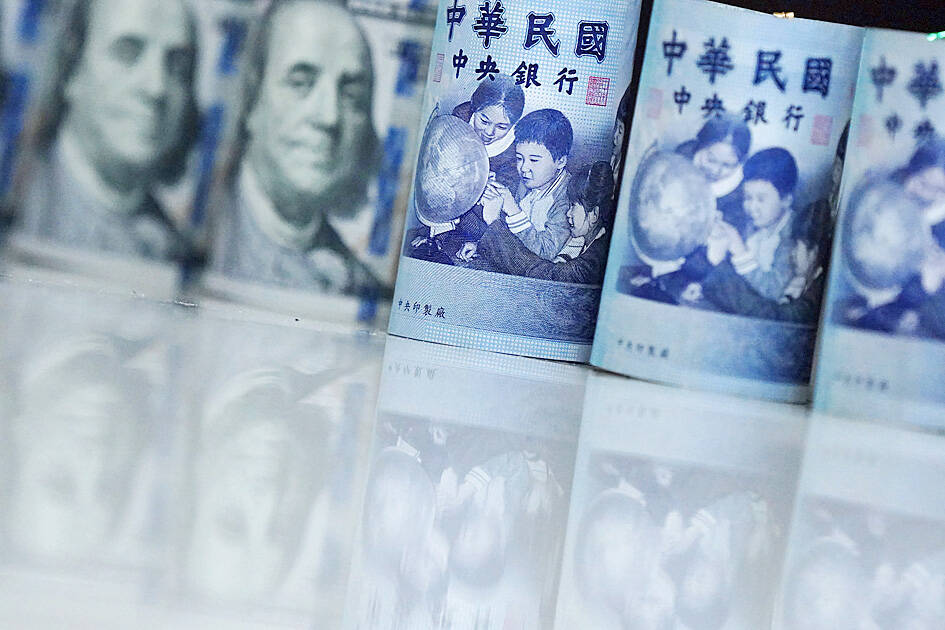The nation’s foreign exchange reserves rose for a seventh straight month to US$562.87 billion last month, an increase of US$1.75 billion, mainly on the back of interest income and management returns, the central bank said yesterday.
The monetary policymaker collects the bulk of its annual interest income in the months of February, May, August and November, Department of Foreign Exchange Director-General Eugene Tsai (蔡炯民) said, declining to supply more details.
Taiwan is the world’s sixth-largest foreign exchange reserve holder after China, Japan, Switzerland, India and Russia.

Photo: CNA
“The foreign currency market has held relatively stable so far this year, requiring little need for intervention except for a few days,” Tsai told an online media briefing.
The central bank has made clear its stance that interventions are part of its policy to maintain the currency market’s stability whenever necessary, as the US Federal Reserve and the European Central Bank rely on quantitative easing or tightening for similar purposes, he said.
The local currency traded within a narrow range and ended down 0.03 percent last month versus the US dollar, as strong job data in the US somewhat eased recession fears and lent support to the greenback, Tsai said.
That was also why other currencies weakened against the greenback, with the yen shedding 4.28 percent, the euro losing 2.62 percent, the yuan softening 2.73 percent and the Australian dollar slipping 2.02 percent, he added.
The Fed is likely to hold interest rates unchanged later this month in light of top-ranking Fed officials’ support for a pause this month and see how things pan out, Tsai said.
Foreign fund inflows also contributed to the increase in Taiwan’s foreign exchange, as portfolio managers raised holdings of local semiconductor shares following the strong earnings results of Nvidia Corp, a US supplier of chips used to power artificial intelligence (AI) applications.
Taiwanese tech companies supply key components used in AI chips and servers.
Net fund inflows of US$5 billion offset unfavorable twists linked to poor exports and current account retreats, Tsai said, adding that a tourism account deficit induced by a foreign travel binge also weighed on the local currency.
As of May 31, securities and debts held by foreign institutional investors totaled US$587.2 billion, or 104 percent of foreign exchange reserves, which is healthy, the central bank said.

The US dollar was trading at NT$29.7 at 10am today on the Taipei Foreign Exchange, as the New Taiwan dollar gained NT$1.364 from the previous close last week. The NT dollar continued to rise today, after surging 3.07 percent on Friday. After opening at NT$30.91, the NT dollar gained more than NT$1 in just 15 minutes, briefly passing the NT$30 mark. Before the US Department of the Treasury's semi-annual currency report came out, expectations that the NT dollar would keep rising were already building. The NT dollar on Friday closed at NT$31.064, up by NT$0.953 — a 3.07 percent single-day gain. Today,

‘SHORT TERM’: The local currency would likely remain strong in the near term, driven by anticipated US trade pressure, capital inflows and expectations of a US Fed rate cut The US dollar is expected to fall below NT$30 in the near term, as traders anticipate increased pressure from Washington for Taiwan to allow the New Taiwan dollar to appreciate, Cathay United Bank (國泰世華銀行) chief economist Lin Chi-chao (林啟超) said. Following a sharp drop in the greenback against the NT dollar on Friday, Lin told the Central News Agency that the local currency is likely to remain strong in the short term, driven in part by market psychology surrounding anticipated US policy pressure. On Friday, the US dollar fell NT$0.953, or 3.07 percent, closing at NT$31.064 — its lowest level since Jan.

The New Taiwan dollar and Taiwanese stocks surged on signs that trade tensions between the world’s top two economies might start easing and as US tech earnings boosted the outlook of the nation’s semiconductor exports. The NT dollar strengthened as much as 3.8 percent versus the US dollar to 30.815, the biggest intraday gain since January 2011, closing at NT$31.064. The benchmark TAIEX jumped 2.73 percent to outperform the region’s equity gauges. Outlook for global trade improved after China said it is assessing possible trade talks with the US, providing a boost for the nation’s currency and shares. As the NT dollar

The Financial Supervisory Commission (FSC) yesterday met with some of the nation’s largest insurance companies as a skyrocketing New Taiwan dollar piles pressure on their hundreds of billions of dollars in US bond investments. The commission has asked some life insurance firms, among the biggest Asian holders of US debt, to discuss how the rapidly strengthening NT dollar has impacted their operations, people familiar with the matter said. The meeting took place as the NT dollar jumped as much as 5 percent yesterday, its biggest intraday gain in more than three decades. The local currency surged as exporters rushed to